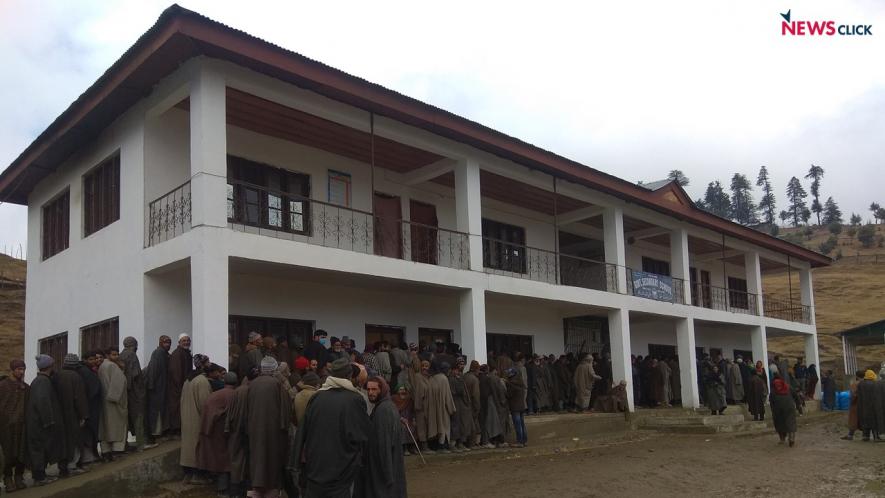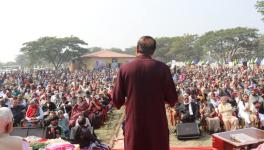DDC Polls: Democracy Hits the Ground Running, and a Chasm also Widens

The recently announced election results to the District Development Council (DDC) elections in Jammu and Kashmir will be followed with interest within the erstwhile state, nationally and internationally. These polls marked the first mass electoral exercise after the de facto abrogation of the special status of Jammu and Kashmir and its bifurcation into two Union Territories in August 2019.
The significance of the DDC elections cannot be underestimated. This was the first time that people in Jammu and Kashmir voted for new governance institutions under the 73rd Amendment of the Constitution. On the plus side, the institutional lesson about the importance of holding free and fair elections in Jammu and Kashmir was upheld. Due to the BJP’s current strategy of organising no-holds-barred electoral campaigns across India, a fear was expressed in some quarters that these polls may be rigged in favour of the BJP. The fact that rigging elections in Jammu and Kashmir was not too uncommon in the past gave credence to these fears.
The first time that fair elections were held in Jammu and Kashmir was the 1977 Assembly election under the prime minister Morarji Desai-led Janata Party. The Janta Party shared power with the then Bharatiya Jana Sangh, the earlier incarnation of the BJP in which one of its founders, Atal Bihari Vajpayee, was the foreign minister. In that election, Kashmiris voted against the ruling Janta Party at the Center and in favour of the regional party, the National Conference. Thus, the notion that in Kashmir a vote against the party ruling at the Center is also a vote against India was corrected. But within a span of ten years, the past institutional practice of rigging again hounded the people of the Valley. The rigging of the 1987 Assembly election for instance, is now overwhelmingly considered the single most important trigger for the onset of militancy in Jammu and Kashmir in 1988-89.
In 2002, there were fears that the Assembly elections would be rigged in Jammu and Kashmir in favour of the National Conference, an ally of the then ruling BJP-led NDA government. Then prime minister, Vajpayee, became the first Indian PM to openly admit that the federal government had rigged past elections in Jammu and Kashmir and invited international observers to witness the election process. Now, rigging-free DDC polls have been conducted in Jammu and Kashmir—with the caveat that there were allegations that People’s Alliance for Gupkar Declaration (PAGD) leaders were not allowed to canvass. They also reported that candidates were being prevented to campaign in militancy-infested areas by not being provided security.
Second, more than 72% of the population lives in the rural areas of Jammu and Kashmir. A separate governance model existed in the form of non-elected district developments boards. This was the negation of principle of democratic decentralisation. A single-line administration model was formulated in 1976 with a Cabinet minister given responsibility for each district. The practical reality was that district plans were approved annually on a single day in a meeting presided by the respective Cabinet minister.
It is a fact that successive Jammu and Kashmir governments had pussyfooted on the issue of fuller implementation of the 73rd Amendment. The issue came up frequently in the legislature of the [former] state through various Private Member Bills, but the approach of the political elite had been to keep the polity centralised.
The central government amended the Jammu and Kashmir Panchayati Raj Act, 1989, which was governed by the Panchayati Raj Act and Rules, 1996, to provide for the establishment of elected District Development Councils in Jammu and Kashmir. In the otherwise over-centralised polity of Jammu and Kashmir, which is known for its diversity, including regional, religious, ethnic and geographical, the elected DDCs, even with some flaws, will ensure elected grassroots governance in the far-flung areas.
Third, unlike in the national elections, there was no boycott call from separatists during these local polls. The voter turnover in the 2019 Lok Sabha election in the Baramulla, Srinagar and Anantnag Parliament constituencies of Kashmir Valley was 34%, 14% and 8.76% respectively. In South Kashmir, which falls within Anantnag Parliament constituency, Kulgam reportedly recorded 28.9% polling in the DDC polls while Shopian recorded 17.5%. Within the Srinagar Parliament constituency, Ganderbal district is said to have recorded 43.4%. In North Kashmir’s Bandipora district, which falls in the Baramulla Parliamentary constituency, the polling turnout was reported at 51.7%. The high voter turnout in areas that are synonymous with political disaffection and violence in the Kashmir valley demonstrates the enthusiasm of the people for grassroots democracy.
However, one cannot be indifferent to the broader political and social context. Jammu and Kashmir are witnessing a sharpening of religious polarisation and the voting pattern is in accordance with that trend. Progressively, parts of Jammu and Kashmir that have a predominantly Hindus population are voting overwhelmingly for the Prime Minister Narendra Modi-led BJP whereas the Muslim-majority areas, including the Valley and hilly areas of Jammu province, are voting against the BJP.
In the past, the National Conference had managed to create a loyal voter base among sections of Jammu Hindus, particularly the Dalits. The Dalits were beneficiaries of the National Conference-initiated land reforms in 1950, in which one of the central tenets was the provision of land to the tiller. Dalits comprise nearly 19.44% of the population of Jammu province. However, at the macro level, the trend of North India’s all-caste Hindu consolidation in favour of BJP continues to trump the National Conference’s once notable claim over a slice of Dalit vote bank.
The BJP’s highest vote share in these polls is also largely on account of Hindu consolidation in Hindu-majority districts of Jammu province, that recorded a high voter turn-out: Samba (73.65%), Reasi (81.92%), Jammu district (69.39%) and Udhampur (60.49%). In Jammu province, BJP’s voting percentage had come down from 59.3% in the 2019 Parliamentary election to 34.4%. This fall may also be on account of the fact that DDC elections were held in rural areas and the BJP, like in the rest of North India, is traditionally stronger in urban areas.
In geographically and religiously diverse Jammu province, with nearly 30.69% Muslim residents, the BJP won 71 seats securing a decisive victory in district councils of Jammu—Udhampur, Samba, Kathua and Reasi. BJP won Doda, which has nearly 53% Muslims and 45% Hindus, due to the consolidation of Hindu voters, while the Muslim voters split among many parties. The National Conference, the Congress and independent candidates secured victories in the districts of Ramban, Poonch, Rajouri and Kishtwar. Each of these districts have at least 55% Muslim population.
Broadly, the clear victory of the National Conference, the Peoples Democratic Party and other parties of the PAGD in religiously and ethnically homogenous Kashmir valley, with 97.16% Muslims, was no surprise. With feeble existence of Congress party, the de facto reality is of a consolidation against BJP of the Valley’s and Jammu province’s Muslims, which includes a large chunk that is ethnically quite different from Kashmiri-speaking Muslims. Nearly 13% of the elected are reportedly Gujjar Muslims, a distinct ethnic group of Jammu and Kashmir, who have a presence in the Valley and Jammu province.
The establishment of grassroots structures of democratic governance is important, but equally notable is the broader political and societal context. The growing split of Jammu and Kashmir’s voters along religious lines, with no structural institutions to bind them together in their diversity, remains a source of perennial worry. Those who have been eye witnesses to the three decades of conflict in the region know that a religiously-polarised landscape is a powder keg for violent forces to exploit on both sides of the Pir Panjal, the mountain range that geographically divides the Valley from the Jammu region. In this context, grassroots democracy in Jammu and Kashmir needs to be celebrated, but one must be aware of the growing divisions that could reverse these gains.
The writer is the author of Across the LoC published by Columbia University Press. The views are personal.
Get the latest reports & analysis with people's perspective on Protests, movements & deep analytical videos, discussions of the current affairs in your Telegram app. Subscribe to NewsClick's Telegram channel & get Real-Time updates on stories, as they get published on our website.
























